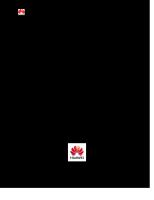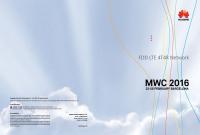LTE Carrier Aggregation [PDF]
LTE carrier Aggregation LTE is specified in 3GPP release 8 and 9. LTE advanced is specified in 3GPP release 10. The main
52 0 812KB
Papiere empfehlen
![LTE Carrier Aggregation [PDF]](https://vdoc.tips/img/200x200/lte-carrier-aggregation.jpg)
- Author / Uploaded
- Amit Upadhyay
Datei wird geladen, bitte warten...
Zitiervorschau
LTE carrier Aggregation LTE is specified in 3GPP release 8 and 9. LTE advanced is specified in 3GPP release 10. The main difference between them is, carrier aggregation has been introduced in LTE Advanced. Also the number of antennas supported by MIMO has been increased to 8 in LTE Advanced. 1. Carrier Aggregation Carrier aggregation (CA) is used in LTE-Advanced in order to increase the bandwidth, and thereby increasing the bitrate. Hence it will support higher data rate compared to non-CA device. It is applied for both TDD and FDD (DL Speeds up to 1 Gbps and UL Speeds up to 500Mbps). Each aggregated carrier is referred to as a component carrier, CC. The component carrier can have a bandwidth of 1.4, 3, 5, 10, 15 or 20 MHz and a maximum of 5 component carriers can be aggregated, hence the maximum aggregated bandwidth is 100 MHz. In FDD the number of aggregated carriers can be different in DL and UL. However, the number of UL component carriers is always equal to or lower than the number of DL component carriers. The individual component carriers can also be of different bandwidths. For TDD the number of CCs as well as the bandwidths of each CC will normally be the same for DL and UL.
1.1 Types of CA 1. Intra-band contiguous - The component carriers belong to the same operating frequency band. This might not always be possible, due to operator frequency allocation scenarios. E.g. 3C, 7C, 38C 2. Intra-band non-contiguous - The component carriers belong to the same operating frequency band, but have gaps, in between so that they don’t overlap. E.g. 3A-3A, 7A-7A.
3. Inter-band non-contiguous – The component carriers belong to different operating frequency bands so they have gaps in between. E.g. 3A-7A, 7A20A, 3A-38A.
1.2 Carrier Aggregation - Secondary Cells (SCell) In CA the UE is camped to only one cell (PCell) called the Primary serving cell, served by the Primary component carrier (PCC). The other component carriers are all referred to as Secondary component carriers (SCC), served by the Secondary serving cells (SCell). The SCC’s are added and removed as required, while the PCC is only changed at handover. If the UE is configured with one or more SCells, the Enodeb may activate and deactivate the configured SCells. Activation/Deactivation does not apply to PCell. When 2 CC’s are combined it is called 2 Carrier Aggregation (2CA). Similarly, we can combine 3CC, 4CC and 5CC and are called as 3CA, 4CA and 5CA, respectively. Below diagram shows the throughput based up on number of component carriers when combined.
A typical use case of activation of the SCell would be when there is a need of more data to delivered to the UE in the downlink, the network can activate several secondary CCs to maximize downlink throughput. Another use case could be that if the PCell is fully loaded, the SCell can be activated and the data transfer can be scheduled only on the SCell (Load balancing). The network can deactivate the SCell when there is no more data to be delivered to the UE or the channel quality of the SCell turning to be bad. SCell Activation is done via MAC Control Element whereas the deactivation mechanism is either by using MAC control element or by the expiry of the SCellDeactivationTimer. 1.3 CA Bandwidth Class It indicates a combination of maximum ATBC (Aggregated Transmission Bandwidth Configuration) and maximum number of Component Carriers (CC).
1.4 Intra-band contiguous channel spacing For Intra-band contiguous we have to take in to account the nominal channel spacing. For intra-band contiguous carrier aggregation with two or more component carriers, the nominal channel spacing between two adjacent E-UTRA component carriers is defined as the following:
where BW Channel(1) and BWChannel(2) are the channel bandwidths of the two respective E-UTRA component carriers. PCC – Primary Component Carrier (PCell) SCC – Secondary Component Carrier (SCell) For example: 2CA band 40C If we are planning to set a PCell of bandwidth 20 MHz(BW1) and a SCell of bandwidth 20 MHz(BW2) then the nominal spacing will be calculated as follows, Nominal Channel Spacing = FLOOR.MATH((20+20-0.1*ABS(20-20))/0.6)*0.3 = FLOOR.MATH((40+0.1*0)/0.6)*0.3 = FLOOR.MATH(40/0.6)*0.3 = FLOOR.MATH(66.6666667)*0.3 Nominal Channel Spacing = (66)*0.3 => 19.8 MHz NOTE: (You can put the line “FLOOR.MATH((20+20-0.1*ABS(20-20))/0.6)*0.3” directly into Excel and it should give you 19.8). Which means for Intra-band contiguous the Channel Spacing should be a multiple of 300 KHz and equal to (or) less than Nominal Channel Spacing, Channel Spacing < Nominal Channel Spacing Channel Spacing = ((BW1+BW2)/2). If we take the PCC EARFCN=39000, Frequency=2335, Bandwidth=20 MHz then the SCC is calculated as, SCC EARFCN = PCC EARFCN + 19.8 * 10 = 39000 + 198 = 39198 SCC EARFCN=39198, Frequency=2354.8, Bandwidth=20 MHz The Nominal Channel Spacing is 19.8 MHz (2335 – 2354.8) which is less than or equal to Channel Spacing of 19.8 MHz. Only when this condition is satisfied it is treated as Intra-band contiguous.
For intra-band non-contiguous carrier aggregation the channel spacing between two E-UTRA component carriers in different sub-blocks shall be larger than the nominal channel spacing. (ie) The combination is considered as 40A-40A, Channel Spacing > Nominal Channel Spacing The same method, but let’s say for 2CA band 7C with 10 and 20 MHz bandwidth and PCC EARFCN=3100, Nominal Channel Spacing = FLOOR.MATH((10+20-0.1*ABS(10-20))/0.6)*0.3 = 14.4 MHz SCC EARFCN = 3100+14.4*10 = 3244 Similarly, for bandwidth 10 + 10 Nominal Channel Spacing = 9.9MHz. For bandwidth 10 + 5 Nominal Channel Spacing = 7.2MHz. For bandwidth 5 + 5 Nominal Channel Spacing = 4.8MHz.
1.5 Difference between Primary Cell and Secondary Cell (PCell vs SCell)
2. Understanding the CA Downlink Band Combinations from UE Capability Lets have a look at how the LTE downlink CA band combinations are retrieved from the "UE Capability Information" message. The list of downlink CA band combinations supported by the UE are mentioned under the IE “supportedBandCombination-r10”. The element “bandEUTRA-r10” mentions the LTE bands and the element “ca-BandwidthClassDL-r10” mentions the Aggregated Transmission Bandwidth Combination a, b or c in downlink. In Carrier Aggregation downlink there is only one PCell(Serving cell) but can contain any number of SCell's(Neighboring cell). In downlink CA combination there will only be one LTE band with both the elements "ca-BandwidthClassDL-r10" and "ca-BandwidthClassUL-r10". This will always be the PCell and the other bands will be the SCell(s). In the below figure, there are some examples of how to find the 2CA and 3CA band combinations in downlink. When you understand 2CA & 3CA then you will easily understand how to find 4CA & 5CA combinations from the UE capability.
In the below figure you will see some examples of 2CA band combinations. The supported 2 CA downlink band combinations are 3a-7a, 3c and 3a-3a.
In the below figure you will see some examples of 3CA band combinations. The supported 3 CA downlink band combinations are 3a-7a-20a and 3c-7a.
3- Understanding the CA Uplink Band Combinations from UE Capability UL CA combines two or more component carriers, transmitted from a UE to the wireless base station, dramatically increasing the speed with which a user can upload content and files. As of now there is only 2 carrier aggregation (2CA) in uplink. Therefore in Carrier Aggregation uplink there is only one PCell(Serving cell) and only one SCell(Neighboring cell). Lets have a look at how the LTE uplink CA band combinations are retrieved from the "UE Capability Information" message. The list of uplink CA band combinations supported by the UE are mentioned under the IE “supportedBandCombination-r10”. The element “bandEUTRA-r10” mentions the LTE bands and the element “ca-BandwidthClassUL-r10” mentions the Aggregated Transmission Bandwidth Combination a, b or c in uplink. In uplink CA combination both LTE bands will contain the elements "ca-BandwidthClassDLr10" and "ca-BandwidthClassUL-r10". In this case the PCell and SCell can be any(However the UE selects its PCell and SCell based up on the priority set by the network operator). In the below figure you will see some examples of 2CA band combinations. The supported 2 CA uplink band combinations are 3c and 3a-20a/20a-3a.
LTE category 6: LTE Category 6, as laid out by 3GPP, is a platform designed to allow for increased connectivity and speeds, and to provide a basis upon which further, more advanced networks as defined by LTE Cat. 9 and LTE Cat. 11 can be built upon. But what exactly is LTE Cat 6? In this article, we’ll take a look at the basics about this technology, and discuss where it’s been implemented worldwide LTE Cat 6 Doubles The Speeds Offered By LTE Networks LTE networks, as laid out in 3GPP release 4, have a maximum bit rate of approximately 150 Mbit/s, but most LTE networks in America have still not even implemented release 4 – and are still using Cat 3. networks with maximum bandwidth throughputs of less than 100 Mbit/s. The LTE Cat 6 network is a method by which speeds can be easily doubled or tripled. There are two primary methods by which these speeds can be achieved.
Method1: Dual
Band
Antenna
Most modern smartphones actually already have this capability built in, and have been designed with both 2600-MHz and 1800-MHz frequency antennas built in. Even older phones, like the iPhone 5s, have this capability. Basically, this allows wireless providers to built two synchronized, simultaneous frequency bands on top of each other, and by more evenly distributing traffic across their networks, they will be able to increase
the
speed
–
even
of
people
who
lack
dual
band
antennas.
Think of phones with dual-band antennas like sports cars – when the 2600MHz band is opened up, they’ll be able to switch lanes, and those of us stuck on the 1800MHz frequency will be able to take advantage
of
their
absence
by
speeding
up.
By allowing traffic to be distributed across multiple frequencies, the speed of the entire network will increase, and dual-band phones will be able to hit download speeds of oup to 300 Mbit/s.
Method 2: LTE Carrier Aggregation is a very complex concept – if you’d like a thorough, technical explanation, head over to 3GPP – but we’ll break it down for you here. Essentially, LTE carrier aggregation allows “component carriers” to aggregate into more effective, high-bandwidth networks. Currently, up to 5 component carriers can be combined, each with a maximum bandwidth of 20 MHz – meaning that an aggregated
LTE
carrier
can
have
up
to
100
MHz.
The interesting part of LTE carrier aggregation is not all of your component carriers have to be the same bandwidth – you can utilize underused, lower-bandwidth carriers to take some of the load off of higher bandwidth carriers. This allows for overall faster speeds, better efficiency, and a much more responsive network.
LTE
Cat
6
Is
The
Future
3GPP has a history of creating wireless standards long before they can be used. In fact, the first LTE standard was supported only by specific wireless routers at its
inception in 2007 – cellphones complex enough to use the first LTE standards didn’t come into being until about 2013. So while LTE Cat 6 adoption is slow in the United States, its certainly the future of wireless connectivity both in the US and abroad, and once these technologies are fully implemented, it will certainly revolutionize how we communicate with each other – and with wireless networks.









